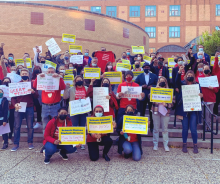
It’s no secret that Massachusetts has been hit hard by COVID, but for low-income and communities of color, it’s been particularly damaging. For Chelsea teachers, one of Massachusetts poorest communities, they’ve been ringing the crisis alarm for decades. We sat down and spoke with Kathryn Anderson, President of the Chelsea Teachers’ Union, about historical lack of investment and what a new flush of $40M could mean for students and educators..
“Chelsea was hit hard by COVID,” said Anderson. “It was only made worse because our community as a whole has been underserved, underfunded, and underemployed.” Local school districts have become a magnifying glass for the intersection between community, young people, and educational workers. Anderson adds, “it’s not just about all these things coming together, but it tells the story of what districts have been going through for a very long time.” Chelsea has endured drastic budget cuts for decades, leaving educators and students worse for the wear. “The biggest pressure we’ve seen is increasing class sizes and community pressures. Nearly half of our student population have experienced a food and /or housing crisis and over 80% of our community has lost income or had a major health crisis.”
Due to the damage COVID has caused and continues to do to our communities, a huge focus has shifted to mental and emotional support, but with little capacity to actually help. “We have been putting more and more pressure on fewer backs. For example, we only had 3 special educators for 600 students. 1.5 social workers for 500-600 students, or only 6 social workers in our high school with 1,400 students. This ratio is unsafe and leaves tons of room for folks to fall through the cracks.” Chelsea has a large population of immigrant families and students and Anderson is quick to highlight how this hurts multi-language learning students in particular. “For multi-language learners, 20-30 students per teacher is NOT a classroom environment kids need or deserve. We can’t ensure they’re getting the skills they need.”
Unsafe workloads and imbalanced student-to-teacher ratios are not new to Chelsea, but the compounding impacts are unavoidable. “We have a 10% higher rate of turnover compared to the surrounding districts. We continue to miss out on deep learning, resulting in low MCAS scores. There isn’t time or teacher availability for students to build a relationship with teachers.” said Anderson. “We feel like a community who has worked hard to be frontline workers to just be tossed away.”
When comparing Chelsea to other communities, you’ll find that the Chelsea school district is fairing worse than their neighboring communities. Across the board, wage gaps for educators, student performance gaps and community success markers are all lower in Chelsea. “The funny thing is, I could drive a short 5 minutes and be in a completely different district with completely different access to resources that I don’t have here in Chelsea,” Anderson explained. “This is why we’re fighting to ensure the influx of funds is used appropriately to get Chelsea on a level playing field.”
Between ESSER II and III funds, Student Opportunity Act funds, and Charter reimbursements, the district is expected to witness nearly $40M coming into the district. Anderson explains that a thoughtful and effective plan is needed, one that includes teacher input. “We’re having to push for the things we need. ESL educators, social and emotional support with reduced caseload sizes for social workers, and pay that is on par with surrounding districts.” Anderson continues, “We need individualized support for students in our classrooms, smaller class size and caseloads. We’re fighting for paraprofessional and educator prep periods to collaborate. This would allow teachers to plan more project based learning and connect their culture to real life solutions.” Lastly, Anderson returns to the needs for all educators across Chelsea. “We must focus on teacher retention by building an industry we’re proud to be a part of. This is a major factor considering Chelsea teachers are paid 16% less than those only a mere mile away.”
Chelsea is in contract negotiations because of the new financial context teachers are in, given this new influx of dollars. “We’re shifting from a scarcity, survival mentality to one that is focused on abundance.” To demonstrate the seriousness of these negotiations, Chelsea educators, teachers, staff and community leaders led a rally and walk-out before classes began on October 18th. The rally was held to demand a fair contract that delivers on the promise of well resourced schools for their students, families, and educators. While talks have been in good faith, Chelsea educators are nervous the state won’t deliver on the promise to fund their schools. With educators having been on the frontlines for decades, watching budget cuts gut their resources, the Chelsea Teachers’ Union is ready to make sure the money comes so kids get the staff and services they deserve.
“The walk was amazing!” said Anderson. “Teaching is such an isolating profession, but time and time again our union has given me hope. When I talk with coworkers, we realize we’re not alone. In fact, we can work together to be the solutions.”
